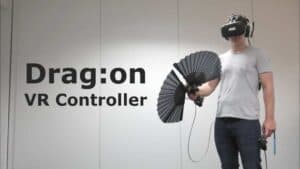The SIGGRAPH 2019 conference brought a number of haptic feedback developments to light. One of the most intriguing addressed a missing element in our current solutions – the sensation of weight in VR. Up to now, our haptic devices have focused on our hands and body. You feel like you are touching or grasping an object, or have the feeling of something passing through you. In its simplest form, the feedback comes through our controllers. More advanced versions require gloves or hardware on our hands. Achieving a full haptic experience usually means wearing a vest or a full-body suit.
The Drag:on controller that brings the sensation of weight in VR isn’t a miniature device. You’re essentially holding a wand in your hands that expands depending on the VR experience. But it’s a start – a significant advance – to achieving the seemingly impossible in virtual reality.
In the long run, we need these solutions. Virtual reality is increasingly interactive and needs to move beyond vibrating hand controllers. Passing an object to Lucy in Wolves in the Walls is an engaging experience. But the one thing that is missing is the sensation of weight.
Achieving the Sensation of Weight in VR
The Drag:on device is from André Zenner and Antonio Krüger, two German engineers at the Research Center for Artificial Intelligence. It’s a dual-folding fan controller that looks like a futuristic tennis racket. The fans open and close depending on the weight or resistance of the object you’re interacting with.
Here’s their four-minute video demonstrating different use cases:
We tried it out at SIGGRAPH and it was incredibly easy to use. The most remarkable aspect of the device is that it’s primarily made out of 3D printed parts and two MG996R servo motors. You could easily create it in a 3D lab or at home with the right hardware. It’s attached to a Vive Tracker though we’d love to see something that could be used with the Oculus Connect controllers.
Devices that bring a sensation of weight in VR are essential for training scenarios in engineering and other fields. Consider what this adds to the experience of tightening a screw or a valve, or lifting and carrying an object. But it’s just as crucial for storytelling in our interaction with characters and avatars in virtual environments.
The Drag:on controller is an initial but remarkable step in replicating the real world in the virtual. We have a way to go before we completely blur that boundary. But it’s the experiments with devices like this that will take us there.
Emory Craig is a writer, speaker, and consultant specializing in virtual reality (VR) and generative AI. With a rich background in art, new media, and higher education, he is a sought-after speaker at international conferences. Emory shares unique insights on innovation and collaborates with universities, nonprofits, businesses, and international organizations to develop transformative initiatives in XR, GenAI, and digital ethics. Passionate about harnessing the potential of cutting-edge technologies, he explores the ethical ramifications of blending the real with the virtual, sparking meaningful conversations about the future of human experience in an increasingly interconnected world.

